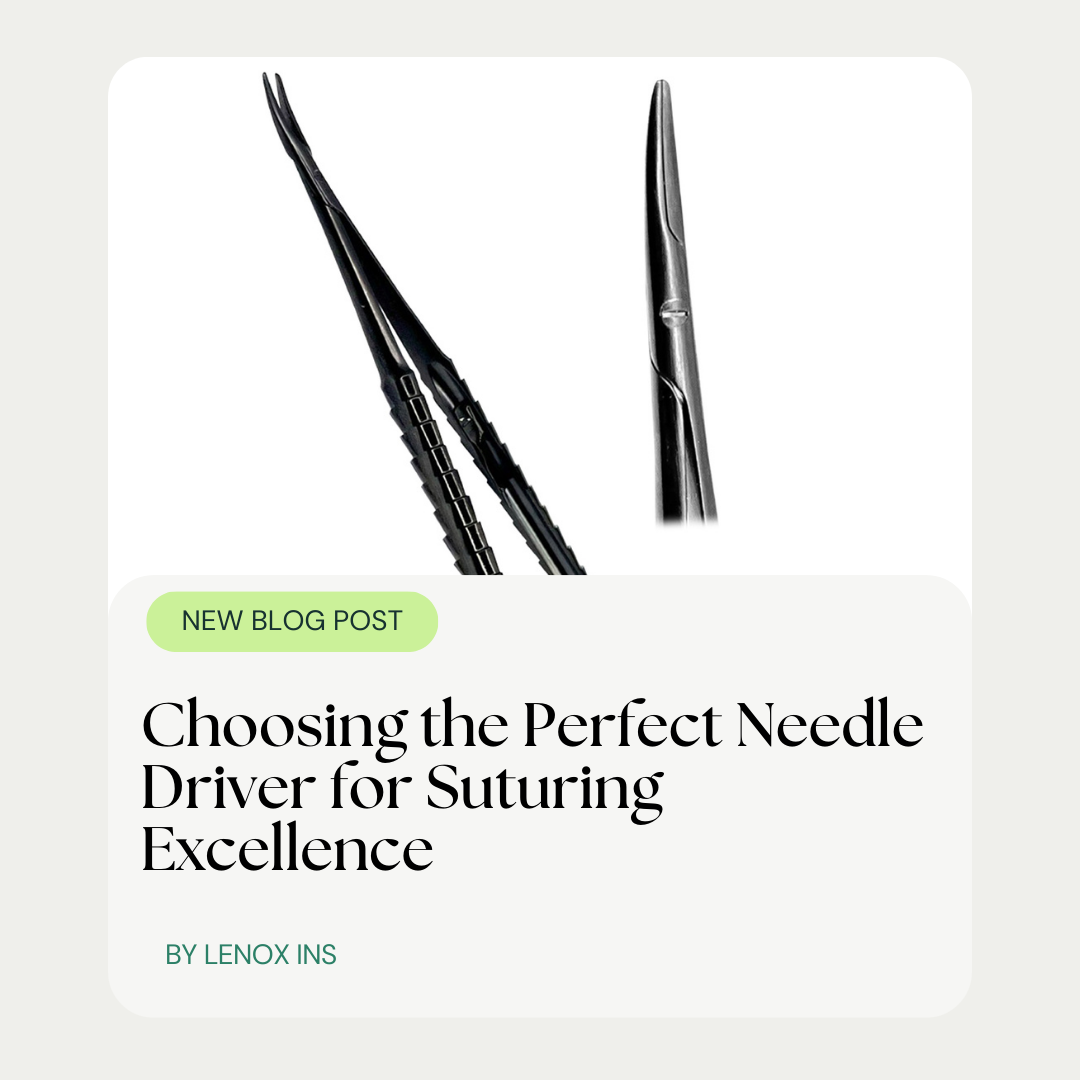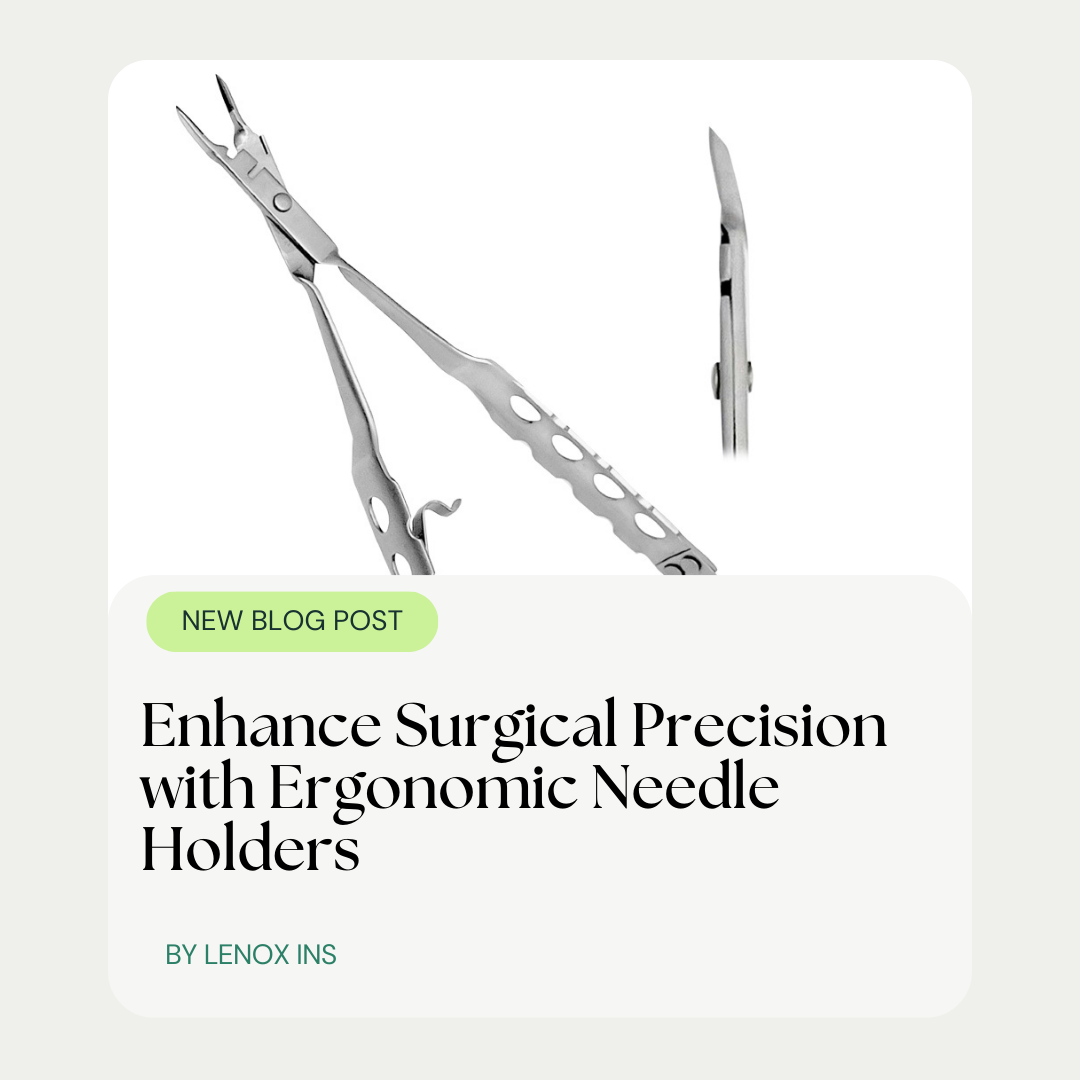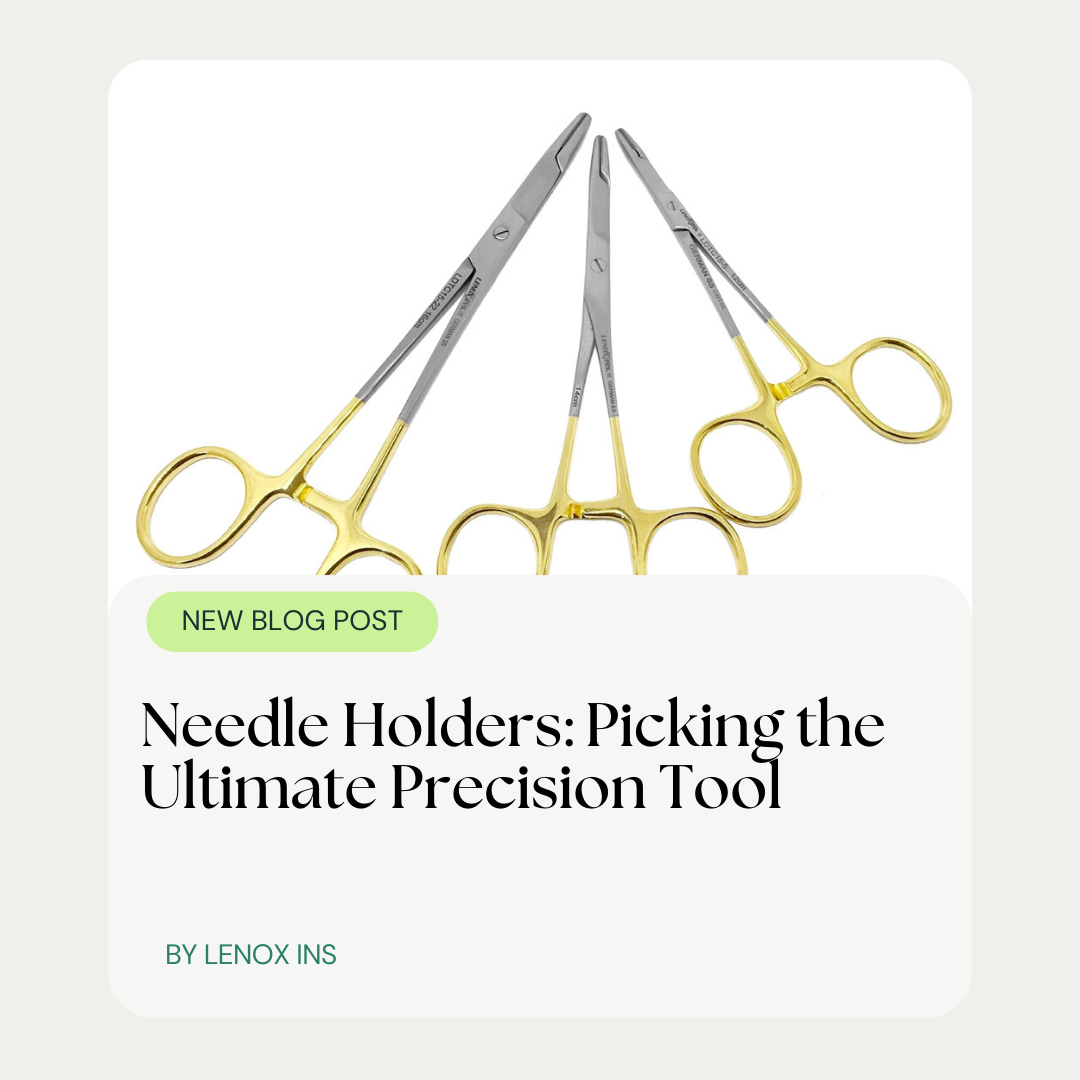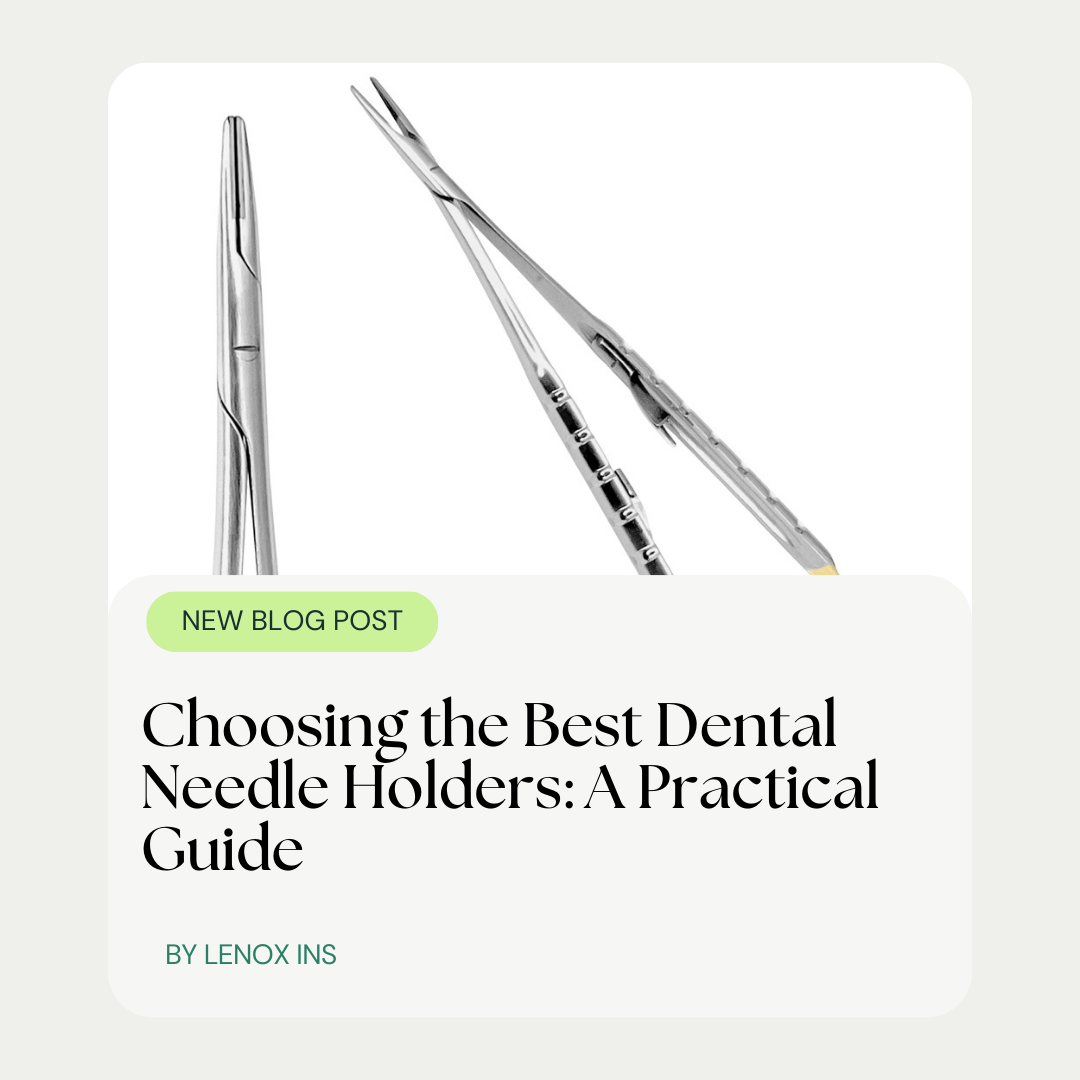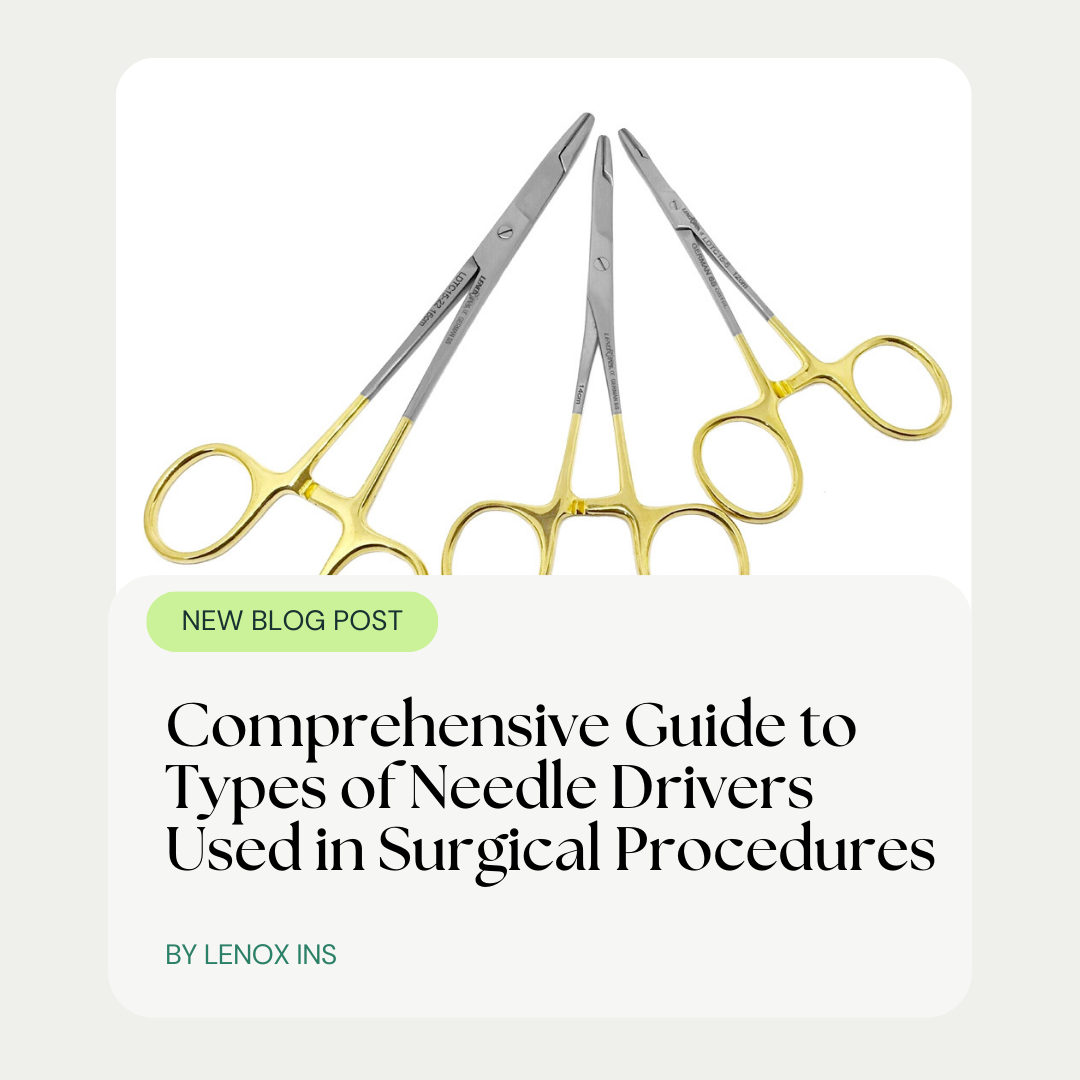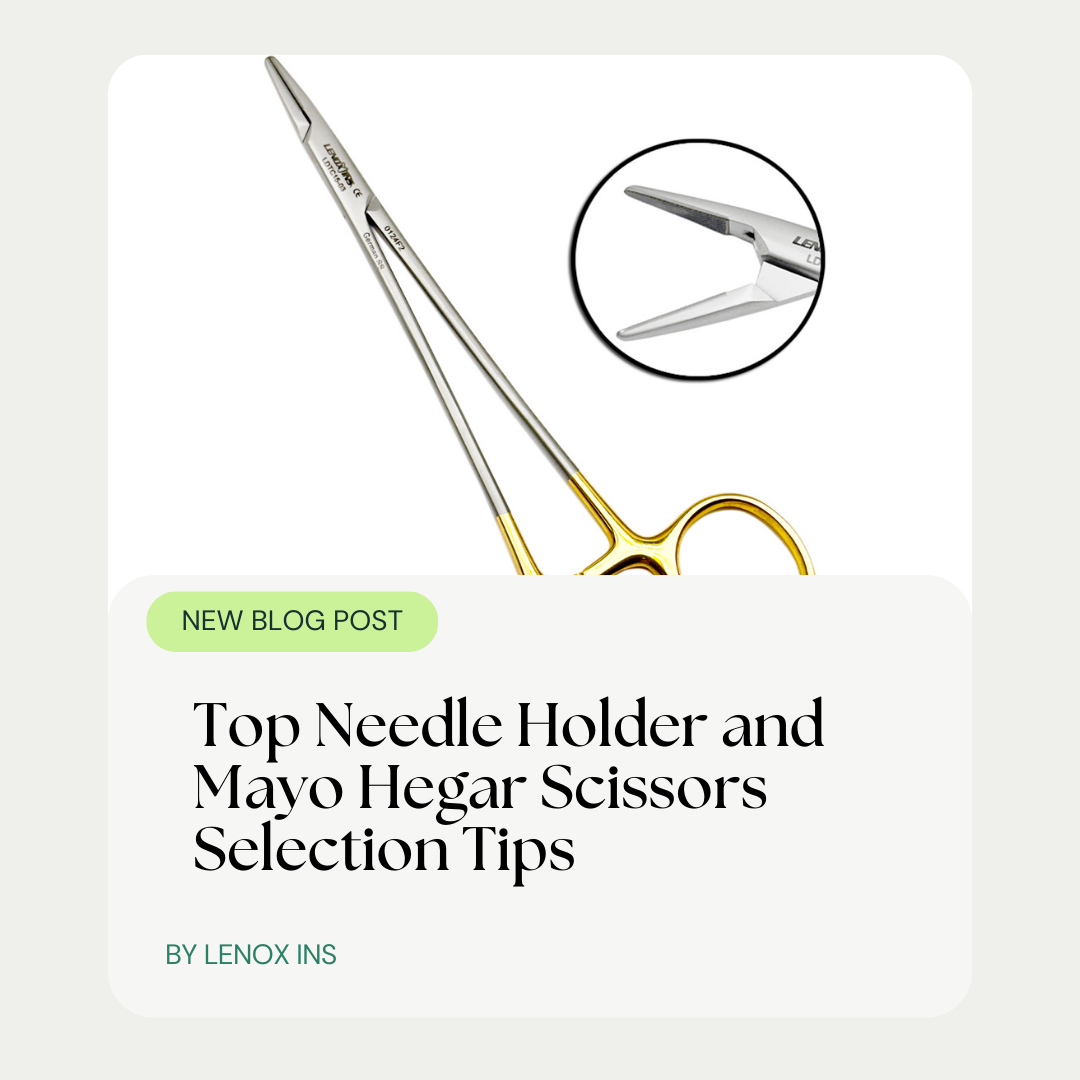Choosing the Perfect Needle Driver for Suturing Excellence
- Posted November 7, 2024
- by lenoxinstro
Choosing the right needle driver is critical for achieving suturing excellence. Many professionals struggle with selecting a needle driver that provides optimal motion and control, especially when working with delicate grafts and dermis layers. This article will explore key features to consider, different types of needle drivers available, and how to match them to specific suturing needs. By understanding these elements, readers will improve their suturing skills and enhance overall procedural outcomes. Addressing the challenges of precision and handling in suturing will lead to better results in these critical tasks.
Key Takeaways
- Selecting the right needle driver enhances suturing precision and efficiency
- Ergonomic design and handle comfort reduce fatigue during lengthy procedures
- High-quality materials ensure durability and effective performance in surgical settings
- Proper maintenance and timely replacement of tools enhance patient safety and surgical outcomes
- Mastering grip techniques significantly improves accuracy and reduces the risk of complications
Understanding the Importance of the Right Needle Driver

The choice of an appropriate needle driver significantly influences suturing precision and efficiency in various medical fields, including plastic surgery and emergency medicine. It plays a critical role in surgical outcomes and patient safety, particularly when handling flaps and injuries. Furthermore, using an improper needle driver can lead to common challenges that compromise suture integrity and clinician comfort, such as difficulty with the index finger positioning. This section will explore each of these aspects in detail.
Impact on Suturing Precision and Efficiency
The selection of the right needle driver directly affects the precision and efficiency of suturing. A well-designed needle driver, crafted from high-quality steel, can enhance control and stability during surgical procedures, allowing for more accurate placement of sutures. Evaluating the curvature of the driver is crucial, as it influences how easily the user can maneuver in tight spaces, while a comfortable grip, typically experienced with the right glove size, ensures that clinicians can maintain dexterity throughout the operation.
The Role in Surgical Outcomes and Patient Safety
The choice of an appropriate needle driver significantly impacts surgical outcomes and patient safety. A quality needle driver allows for precise manipulation of surgical sutures, which is crucial in minimizing pain and reducing the risk of infection in procedures across various specialties, including otorhinolaryngology. Ensuring accurate placement of sutures is essential for effective wound closure and healing, ultimately leading to better patient recovery and satisfaction.
Common Challenges With Improper Needle Drivers
Improper needle drivers can lead to several challenges that affect not only the surgeon‘s experience but also the patient‘s outcome. Issues such as inadequate pressure application can result in insufficient needle penetration or excessive force, leading to potential scars or complications during procedures like bone grafting. Additionally, drivers that lack effective corrosion resistance can undermine their longevity and reliability, increasing the likelihood of malfunction or inconsistent performance during critical surgical moments, particularly when using the ratchet mechanism:
| Challenge | Description | Impact on Surgery |
|---|---|---|
| Inadequate Pressure | Causes difficulty in needle penetration. | Can result in poor suture placement and healing issues. |
| Corrosion | Decreases tool reliability and performance. | May lead to malfunctions during surgery. |
| Poor Ratchet Mechanism | Affects grip and control over the needle. | Increases risk of suture misalignment and complications. |
| Inadequate Design | Can cause discomfort during prolonged use. | May reduce surgeon efficiency and focus. |
Choosing the right needle driver is critical, but understanding its features makes the choice clearer. Let’s explore the key elements that will guide you in selecting the perfect tool for your needs.
Key Features to Consider When Selecting a Needle Driver

Key Features to Consider When Selecting a Needle Driver
When selecting a needle driver, several features are critical to achieving optimal suturing performance. Size and length considerations ensure compatibility with surgical instruments and the epidermis. Handle designs enhance comfort and control, while jaw specifications dictate needle compatibility. Material and durability factors are essential for long-term reliability, and ergonomic features help reduce fatigue during extensive procedures.
Size and Length Considerations
When selecting a needle driver, size and length are essential factors that can significantly affect maneuverability and control during procedures such as endodontics. An appropriately sized needle driver ensures that a clinician’s fingers have the proper leverage, allowing for efficient wrist movement, which aids in achieving precise suture placement. Choosing a driver that fits well within the hand not only enhances comfort but also facilitates quick sterilization and reduces the risk of repetitive strain injuries over time.
- Consider finger placement for optimal grip.
- Evaluate the hand size to promote comfort.
- Ensure the length is suitable for the surgical site.
- Prioritize ease of sterilization to maintain hygiene.
- Assess wrist movement for improved dexterity during procedures.
Handle Designs for Comfort and Control
The design of the handle on a needle driver significantly influences a surgeon‘s comfort and control during procedures, especially in plastic or oral and maxillofacial surgery. An ergonomically designed handle made from high-quality stainless steel allows for better grip and reduces hand fatigue during extended suturing tasks. For instance, a needle driver with a textured handle enhances friction, enabling the surgeon to maneuver the instrument with precision, especially when working with fine sutures or cyanoacrylate adhesives.
- Ergonomic design to enhance grip and comfort.
- Material selection that ensures durability and ease of handling.
- Textured surfaces to improve control during delicate procedures.
Jaw Specifications and Needle Compatibility
Jaw specifications play a crucial role in the overall effectiveness of a needle driver, especially in microsurgery where precision is paramount. The compatibility of the needle driver with various suture types—such as those used in surgical procedures for specific diseases—depends heavily on jaw design and material. Tungsten carbide jaws, known for their durability and superior grip, provide better control over fine needles, enhancing suturing accuracy and contributing to improved patient outcomes.
- Jaw specifications impact overall suturing precision.
- Tungsten carbide jaws offer superior grip and durability.
- Compatibility with various suture types enhances procedural effectiveness.
- Active needle control leads to better patient outcomes.
Material and Durability Factors
Material and durability are vital factors when selecting a needle driver, especially for physicians who perform delicate procedures like a sinus lift. High-quality materials, such as stainless steel or tungsten carbide, ensure that the needle driver withstands the rigors of repeated use while maintaining its effectiveness in gripping sutures and tying knots. Additionally, products approved by the Food and Drug Administration are preferred as they meet stringent safety and efficacy standards, ensuring reliability and confidence during surgical operations.
Ergonomic Features to Reduce Fatigue
Ergonomic features are crucial in reducing fatigue during extended procedures involving suturing, such as in periodontology or orthodontics. A well-designed needle driver, like the Webster needle holder, allows for natural alignment of the thumb and fingers, promoting better grip and control. This thoughtful design aids in minimizing strain on the hand and wrist, enhancing comfort and efficiency for clinicians as they work on intricate suturing tasks with this essential medical device.
Understanding key features sets the stage. Now, it’s time to look at the different types of needle drivers and see what each has to offer.
Exploring Different Types of Needle Drivers

The selection of the right needle driver is crucial for optimal suturing performance and patient safety. Mayo-Hegar needle drivers offer versatility for various surgical tasks, while Olsen-Hegar needle drivers incorporate scissors for efficiency. Castroviejo needle drivers excel in delicate procedures, Ryder needle drivers cater to vascular surgery, and specialized needle drivers address laparoscopic techniques. Each type contributes to effective handling of soft tissue and enhances surgical precision.
Mayo-Hegar Needle Drivers for Versatility
Mayo-Hegar needle drivers are renowned for their versatility in various surgical settings, making them a valuable tool for procedures involving dressing, hemostat, and suturing of subcutaneous tissue. Their robust design allows clinicians to efficiently grasp and manipulate needles while providing the ability to tie knots securely. This adaptability makes Mayo-Hegar needle drivers an excellent choice for surgeons looking to enhance their efficiency during complicated surgeries.
Olsen-Hegar Needle Drivers With Integrated Scissors
Olsen-Hegar needle drivers, featuring integrated scissors, are essential tools for enhancing efficiency in various surgical procedures, particularly in reconstructive surgery. These needle drivers allow surgeons to grasp silk sutures securely and perform precise cutting actions without needing to switch instruments, streamlining the suturing process. Their design is especially beneficial when working with adhesives and fine sutures, as it minimizes the need for excessive movements, thereby reducing the risk of complications and improving overall surgical outcomes.
Castroviejo Needle Drivers for Delicate Procedures
Castroviejo needle drivers are specifically designed for delicate surgical procedures, making them indispensable tools for microsurgeons and ophthalmologists. Their fine tips and precise gripping capabilities allow for meticulous handling of small sutures, facilitating accurate placement even in the most constrained anatomical spaces. This precision is particularly valuable in surgeries such as eyelid repair or suturing small vascular structures, where attention to detail is paramount: Castroviejo needle holder
| Feature | Description | Benefit |
|---|---|---|
| Fine Tips | Allows for precision handling of delicate sutures. | Enhances accuracy in tight or complex procedures. |
| Ergonomic Design | Designed for comfort during prolonged use. | Reduces hand fatigue, promoting efficiency. |
| Durable Materials | Composed of high-quality stainless steel. | Ensures longevity and reliable performance. |
Ryder Needle Drivers for Vascular Surgery
Ryder needle drivers are specifically engineered for vascular surgery, providing surgeons with exceptional control and stability when suturing delicate blood vessels. Their unique design features a tapered jaw and precise grip, making them ideally suited for navigating the intricate anatomy encountered in vascular procedures. By allowing for accurate needle manipulation, Ryder needle drivers enhance the efficiency of suturing and contribute to improved patient outcomes, particularly in scenarios requiring meticulous attention to detail.
Specialized Needle Drivers for Laparoscopic Techniques
Specialized needle drivers designed for laparoscopic techniques are essential tools that enhance precision and efficiency in minimally invasive surgeries. Their unique construction, often featuring a longer reach and slender jaws, allows surgeons to navigate tight intra-abdominal spaces effectively, ensuring accurate suture placement without excessive tissue trauma. The integration of ergonomic grips further supports the surgeon‘s dexterity, minimizing hand fatigue during lengthy procedures: needle holder
- Enhanced control for suturing in confined spaces.
- Longer reach aids in maneuverability.
- Ergonomic designs reduce fatigue during extended use.
- Precision handling decreases the risk of tissue damage.
Each type of needle driver serves a purpose, crafted for different tasks in the operating room. Now, it is important to match these tools to the specific suturing needs at hand to ensure precision and success in every stitch.
Matching Needle Drivers to Specific Suturing Needs

Selecting the appropriate needle driver is essential for achieving suturing excellence across various medical fields. This section addresses the unique requirements for general surgery, emphasizing the importance of versatility. It also covers the specific tools necessary for cardiovascular procedures, the optimal choices for dental suturing, adaptations for veterinary applications, and considerations for ambidextrous use to ensure effective practice for all clinicians. Olsen Hegar needle holder
Selecting Needle Drivers for General Surgery
When selecting needle drivers for general surgery, clinicians prioritize versatility to manage a wide range of suturing tasks effectively. A Mayo-Hegar needle driver, for instance, is often preferred due to its robust design, enabling secure grasping and manipulation of needles during multiple procedures. Additionally, surgeons must consider handle ergonomics and jaw specifications to enhance comfort and improve control, ensuring they can achieve precise suturing outcomes consistently.
Choosing the Right Tool for Cardiovascular Procedures
Choosing the right needle driver for cardiovascular procedures requires careful consideration of the specific demands of this field. Surgeons often benefit from using needle drivers with a tapered jaw design, which enhances control during suturing of delicate blood vessels. Opting for high-quality instruments that offer a precise grip is essential for minimizing the risk of complications, ensuring that the sutures are placed accurately and securely to promote optimal healing and patient safety. Castro Viejo needle holder
Optimal Needle Drivers for Dental Suturing
When selecting needle drivers for dental suturing, professionals often prioritize precision and maneuverability. Needle drivers with fine tips and a lightweight design enable dentists to perform intricate procedures, such as suturing in periodontal surgeries, with greater accuracy. The incorporation of textured grips further enhances control, allowing for secure handling of delicate sutures without compromising comfort during extended use.
Adapting Needle Drivers for Veterinary Applications
Adapting needle drivers for veterinary applications requires consideration of the unique challenges associated with suturing various animal species. Veterinarians often face diverse anatomical structures, with some requiring specialized needle drivers designed to accommodate different suture techniques, particularly in larger or exotic animals. Utilizing lightweight, ergonomic designs can significantly improve precision and comfort during prolonged procedures, enhancing the overall efficiency of surgical interventions and ensuring optimal healing for animal patients.
Considerations for Ambidextrous Use
When selecting a needle driver for ambidextrous use, it is important to consider designs that cater to both left- and right-handed clinicians. Needle drivers with symmetrical handles allow for comfortable grip and control, enabling surgeons to transition between hands with minimal adjustment. Furthermore, implementing features such as adjustable ratchet mechanisms can enhance usability for all practitioners, ensuring consistent performance and efficiency during various suturing tasks.
Choosing the right needle driver is only part of the story. Proper care and maintenance will ensure its performance and longevity, keeping every stitch secure and precise.
Proper Care and Maintenance of Needle Drivers

Proper care and maintenance of needle drivers are essential for ensuring their optimal performance and longevity. This section addresses key practices, including cleaning and sterilization best practices, regular inspections for signs of wear and damage, and safe storage methods that preserve instrument integrity. Additionally, guidelines for timely replacement and troubleshooting common instrument issues will be discussed, providing valuable insights for clinicians aiming to maintain their suturing excellence.
Cleaning and Sterilization Best Practices
Effective cleaning and sterilization of needle drivers are vital for ensuring their longevity and maintaining optimal performance in surgical settings. Clinicians should follow established protocols, including thorough rinsing after each use and utilizing approved sterilization techniques such as autoclaving to eliminate potential pathogens. Regular adherence to these best practices not only extends the life of these essential instruments but also enhances patient safety during surgical procedures:
- Rinse needle drivers thoroughly after use to remove bodily fluids and debris.
- Use autoclaving for sterilization to ensure complete disinfection.
- Inspect needle drivers regularly for wear and potential damages.
- Store instruments in a dry and safe environment to prevent corrosion.
- Replace any damaged tools promptly to maintain surgical standards.
Regular Inspection for Wear and Damage
Regular inspection for wear and damage is essential for maintaining the integrity and performance of needle drivers used in surgical procedures. Clinicians should routinely examine these instruments for signs of excessive wear, such as frayed jaws or deterioration in the gripping surfaces, which can compromise suturing effectiveness. This proactive approach not only ensures optimal suturing precision but also enhances patient safety by reducing the risk of complications associated with inadequate instrument performance.
Safe Storage to Preserve Instrument Integrity
Safe storage of needle drivers is essential for preserving instrument integrity and ensuring their long-term functionality. Clinicians should store these instruments in a dry, clean environment that minimizes exposure to moisture and contaminants, as maintaining the cleanliness of needle drivers directly impacts surgical safety and performance. Utilizing dedicated instrument trays or cabinets can prevent accidental damage and ensure that needle drivers remain in optimal condition, ready for precise suturing when needed:
- Store needle drivers in a designated, dry space.
- Use instrument trays or cabinets to prevent damage.
- Minimize exposure to moisture and contaminants.
- Regularly inspect storage areas for cleanliness.
- Ensure easy access to instruments for efficient workflow.
Guidelines for Timely Replacement
Timely replacement of needle drivers is crucial for maintaining suturing excellence. Clinicians should establish a routine inspection schedule and replace any tool that shows signs of wear, such as dull jaws or compromised gripping surfaces, to ensure optimal performance during surgeries. Monitoring the condition of needle drivers can directly impact surgical outcomes and enhance patient safety.
- Inspect needle drivers regularly for signs of wear.
- Replace tools that show dullness or other damages.
- Maintain a routine inspection schedule to ensure quality.
- Timely replacement enhances surgical performance.
- Consistent monitoring safeguards patient safety.
Troubleshooting Common Instrument Issues
Troubleshooting common instrument issues is vital for maintaining needle driver performance and ensuring successful suturing. Clinicians should be vigilant for signs of wear such as loose jaws, which can affect needle control, or damaged gripping surfaces that may lead to improper suture placement. Regular checks and timely repairs or replacements can prevent complications during surgical procedures, ultimately supporting the overall quality of patient care:
- Inspect for loose jaws that impact needle control.
- Check gripping surfaces for wear to ensure suture integrity.
- Perform regular maintenance to avoid surgical complications.
- Replace damaged tools promptly to uphold surgical standards.
- Monitor instrument performance consistently for optimal results.
With a well-maintained needle driver, the act of suturing becomes more precise and confident. Understanding how to use these tools effectively can elevate a surgeon‘s skill and improve patient outcomes.
Enhancing Suturing Skills With the Right Needle Driver

Mastering various grip techniques significantly enhances suturing skills, as it directly influences accuracy and speed. Understanding how to avoid common errors in needle handling is crucial for maintaining suture integrity. Clinicians can benefit from training resources for continued learning and insights from experienced practitioners, which provide practical knowledge essential for achieving suturing excellence.
Mastering Various Grip Techniques
Mastering various grip techniques with a needle driver significantly improves suturing accuracy and control. For instance, a correct tripod grip allows the clinician to maintain stability while applying force during needle manipulation. Practicing these techniques can help clinicians navigate complex suturing tasks with confidence, ultimately enhancing their overall surgical performance and patient outcomes:
| Grip Technique | Description | Benefits |
|---|---|---|
| Tripod Grip | Using three fingers to stabilize the driver. | Improves stability and force application for needle control. |
| Pinch Grip | Using the thumb and index finger to hold the driver. | Enhances dexterity for delicate suturing tasks. |
| Modified Pencil Grip | Holding the driver as one would a pencil. | Increases precision in tight spaces during procedures. |
Improving Accuracy and Speed in Suturing
Improving accuracy and speed in suturing is essential for successful surgical outcomes, and the right needle driver can significantly enhance these skills. A well-designed needle driver allows surgeons to manipulate sutures with precision, reducing the chances of errors that could lead to complications. By investing time in practicing with a quality needle driver, clinicians can develop muscle memory and coordination, resulting in faster and more accurate suturing, which is crucial for maintaining patient safety and optimizing recovery times.
Avoiding Common Errors in Needle Handling
Clinicians can significantly enhance their suturing skills by being aware of and avoiding common errors in needle handling. For example, improper grip techniques often lead to instability during suturing, which can compromise both precision and patient outcomes. Practicing the correct grip, such as the tripod grip, allows for better control, reducing the risk of handling errors that may result in misaligned sutures or unnecessary tissue damage.
Training Resources for Continued Learning
Clinicians seeking to enhance their suturing skills can benefit from a variety of training resources designed to improve their proficiency with needle drivers. Online courses and workshops offer structured learning modules that cover advanced techniques and the latest best practices in suturing. Additionally, mentorship programs and hands-on training sessions provide practical experience, allowing participants to practice with different needle drivers and refine their skills under the guidance of experienced professionals.
Gaining Insights From Experienced Practitioners
Gaining insights from experienced practitioners offers invaluable knowledge that can enhance suturing skills significantly. Veteran surgeons often share practical tips, such as the importance of selecting a needle driver that suits the specific surgical procedure, which can have a transformative impact on precision and efficiency. They also emphasize the need for regular practice with different needle drivers to develop muscle memory and improve overall handling, ultimately contributing to better patient outcomes in complex procedures.
Conclusion
Selecting the ideal needle driver is crucial for achieving suturing precision and enhancing surgical outcomes. The right instrument not only improves handling but also significantly impacts patient safety and recovery. Clinicians should prioritize ergonomic designs, jaw specifications, and material quality to minimize fatigue and ensure instrument reliability. By investing time in understanding and mastering these tools, healthcare professionals can elevate their suturing skills and contribute to better patient care.

